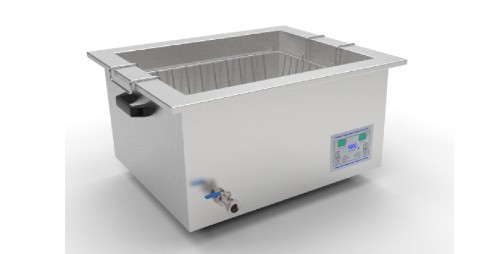The amount of time that a soldier spends cleaning their weapon can vary depending on a variety of factors, such as the type of weapon, how often it is used, the environmental conditions it is exposed to, and the specific cleaning procedures required by the unit or branch of service. That being said, most military branches and units have established cleaning and inspection procedures that are designed to maintain their weapons in a state of readiness and prevent malfunctions. These procedures usually entail field stripping the weapon, cleaning and lubricating its parts and conducting a visual and functional inspection to ensure that it is in proper working order. In general, a soldier can spend anywhere from 15 minutes to an hour or more cleaning their weapon, depending on the complexity of the weapon and the thoroughness of the cleaning required.
Many would argue that this isn’t the best use of soldiers’ time, and since Sergeant Birks’ stand at the Defence and Security Equipment International Expo in September 2019, there is a growing belief that the days of soldiers sitting around and manually scrubbing their weapons are set to become a thing of the past. This blog will explore this interesting idea in greater detail.

Why do you need to clean a firearm?
Soldiers need to clean their firearms to ensure that the weapons are in proper working order and can function reliably in a combat situation. Firearms are complex machines that are subject to wear and tear from regular use, and they can become fouled with dirt, debris and other contaminants that can cause malfunctions or reduce their effectiveness. Regular cleaning and maintenance help to prevent these issues and allow the weapon to always be ready for use. As well as preventing malfunctions, regular cleaning and maintenance will also extend the life of the weapon, and make sure that it can perform at its best over the long term.
Most importantly, cleaning a weapon is also important for safety reasons. When firearms are not cleaned regularly, regardless of whether they’re being used frequently or not, they can become unsafe to use due to the build-up of debris, corrosion or other issues that can cause accidental discharges and malfunctions. By cleaning their weapons regularly, soldiers can help to ensure that the firearm remains safe and reliable for themselves and for their fellow service members.
How do soldiers clean their firearms?
Whilst the specific process for cleaning a weapon may vary slightly depending on the type of weapon and the procedures of the soldier’s unit or branch of service, there are several general cleaning steps to take:
- Clear out the weapon – The soldier must first ensure that the weapon is unloaded, and the magazine removed. They will visually and physically inspect the chamber to make sure that there’s no live ammunition present.
- Disassemble the weapon –The soldier will then dismantle the weapon, removing the barrel, bolt and other components as necessary – this allows the soldier to clean each part thoroughly.
- Clean the weapon – The soldier will use a cleaning solution, such as gun oil or solvent to clean each component of the weapon, removing any dirt, debris or fouling that may have accumulated during use. The soldier will generally use a combination of brushes, rags and other cleaning tools to scrub each part of the weapon.
- Lubricate the weapon – Once the weapon is clean, the soldier will apply a thin layer of lubricant to each component to prevent wear and ensure smooth operation.
- Reassemble the weapon – The weapon will then be reassembled carefully, making sure that all the components are properly aligned and secured.
- Function test the weapon – Finally, the weapon needs to be tested to ensure that all the parts cycle properly and that all safety mechanisms are functional.
What other cleaning methods could there be?
Soldiers have been cleaning their weapons by hand for centuries, right back to the earliest forms of firearms. With the advent of firearms, soldiers began cleaning their weapons by hand to ensure they would be in proper working order and ready for battle. This practice has continued throughout history with soldiers in every army and military around the world continuing to clean their weapons by hand to this day. The fundamental principle of cleaning weapons has remained a critical aspect of military training and readiness.
However, there is a growing realisation that there are other, more effective ways to clean weapons. Sergeant Daniel Birks of the Royal Marines won an innovation funding grant for research and, with the upgrade of the SA80 rifle, began looking into cleaning with ultrasonic machines as an alternative to cleaning by hand. And he believes that ultrasonic cleaners will revolutionise the military’s weaponry cleaning methods.
This blog explains how an ultrasonic cleaner works but, put simply, it sends ultrasonic waves through a solution of water and cleaning solution inside the transducer tank. The soundwaves create a cavity trapped as a tiny bubble which then implodes with force against the item in the tank, displacing grease, dirt and other debris. As the liquid can reach even the tiniest of cracks and crevices, ultrasonic cleaning can reach the most intricate seams and parts of the machinery and give a much more comprehensive clean than is possible by hand.
The implications for the military’s weaponry cleaning methods are massive, as Sergeant Birks discovered that it is possible to clean a whole section’s worth of weapon parts in just 20 minutes in one tank of liquid. Switching to cleaning weaponry parts with ultrasonic cleaners will mean that soldiers’ personal weapon cleaning kits would be extensively reduced – meaning less to carry. The other huge saving would be in up to 60% of the soldiers’ time spent on cleaning.
The manufacturers of the weapons don’t clean parts with oil and metallic brushes, although the military still does and the military currently spends hundreds of thousands of pounds refurbishing damaged weapons each year, and most of the damage is caused by poor cleaning techniques. Ultrasonic cleaning machines would prevent almost all of this damage and therefore save the military money as well as time and effort.
And in conclusion
It certainly seems that the practice of the military cleaning their weaponry by hand is rapidly becoming a thing of the past. With the realisation that ultrasonic cleaning machines can save time and money as well as prolong the life of the equipment, it is clearly the way of the future for the military’s weaponry cleaning.
EJ Ultrasonics is pleased to supply ultrasonic cleaning machines of all sizes and shapes for cleaning a plethora of items from jewellery to engine parts in the automotive and aeronautical industries.
Get in touch today to find out how an ultrasonic cleaner could transform your way of working.


